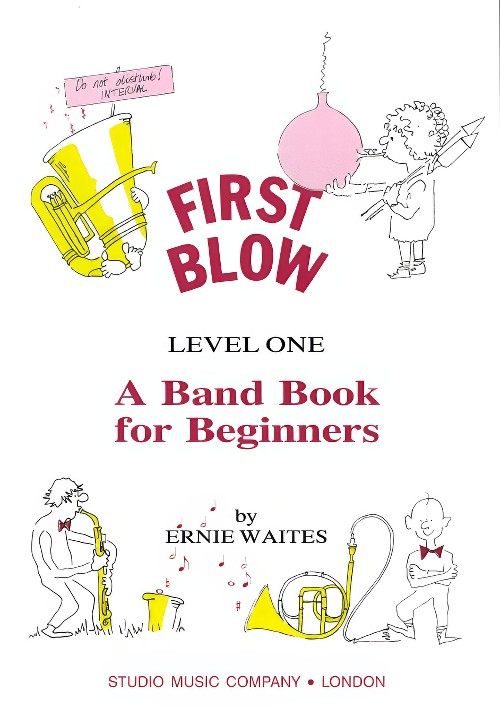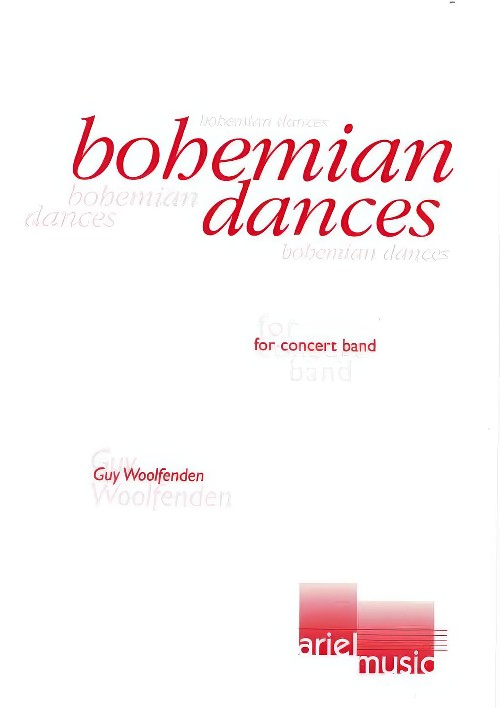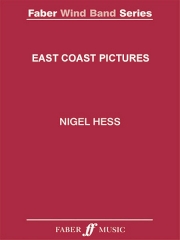Results
-
£150.00
East Coast Pictures - Nigel Hess
East Coast Pictures was commissioned by the British Youth Wind Orchestra with funds from the National Westminster Bank plc. These three short 'pictures' were inspired by several visits to a small part of the American East Coast, an area that provides great extremes in the geography and the people. Movement 1: Shelter Island is a small island situated near the end of Long Island, a few hours drive east of New York. In the summer it becomes a crowded tourist trap; but in the winter it is gloriously deserted and bravely faces the onslaught of the turbulent Atlantic, shrouded in sea mists and driving rain. This 'picture' is a fond memory of a winter weekend on Shelter Island. Movement 2: In upstate New York lie the Catskills Mountains--an extraordinary combination of tranquillity and power, peace and majesty. Once seen, they call you back again and again. Movement 3: New York - or to be more precise, Manhattan. For anyone who is familiar with this bizarre and wonderful city, here is a 'picture' that needs no explanation. For those not yet hooked this is a foretaste of things to come!
In stock: Estimated delivery 1-3 days
-
 £37.37
£37.37Elizabeth Remembered (Wind Band) Debbie Wiseman arr. Andrew Wainwright
Released as a charity single in aid of The Queen's Commonwealth Trust, this sublime work was composed by Debbie Wiseman OBE and performed by the BBC Concert Orchestra in tribute to Queen Elizabeth II after her death in September 2022. This tender and contemplative piece was played many times during the BBC's live coverage of the ceremonies across ten days of national mourning; and the full three-minute piece was played at the end of the Queen's State funeral, following Kirsty Young's emotional final words, and accompanied by a poignant and beautiful montage of images from the events of the day. The piece is now available for wind bands through this arrangement by Andrew Wainwright, with permission kindly granted by Debbie Wiseman. To view a follow-the-score video please visit: www.youtube.com/watch?v=gW6AiNQGKEI Sheet music available from : UK: www.wind-band-music.co.uk USA: www.solidbrassmusic.com Difficulty Level: Medium Easy Instrumentation: Flute Oboe 1 Oboe 2 (Cor Anglais) Clarinet in Bb 1-2 Bassoon 1-2 Alto Saxophone Eb Tenor Saxophone Bb Baritone Saxophone Eb Trumpet in Bb Horn in F Trombone Euphonium Tuba Timpani Harp (optional) Glockenspiel (if no Harp) Suspended Cymbal
In stock: Estimated dispatch 1-3 days
-
 £33.63
£33.63Pastorale (Quem Pastores Laudavere) (Wind Band) Kevin Norbury
VIEW SCORE PDF This beautiful and serene setting of the well known carol Quem Pastores Laudavere features as part of a suite by Kevin Norbury entitled A Renaissance Christmas (available from BrookWright Music). This 14th-century melody was originally collected by Michael Praetorius at the end of the 16th-century. The treatment throughout is very lyrical without overly complex harmonies. The melody is heard three times with brief linking episodes and a short coda. Sheet music available from : UK: www.wind-band-music.co.uk USA: www.solidbrassmusic.com Difficulty Level: Medium-Easy Instrumentation: Piccolo Flute Oboe Bassoon Clarinet in Bb 1-2 Bass Clarinet in Bb Alto Saxophone in Eb 1-2 Tenor Saxophone in Bb Baritone Saxophone in Eb Trumpet in Bb 1-2 Horn in F Trombone Euphonium Tuba Double Bass Timpani Glockenspiel Tubular Bells
In stock: Estimated dispatch 1-3 days
-
 £89.95
£89.95First Blow - Level 1 (Value Set) - Waites, Ernie
The Value Set includes a score and 1 of each part.The aim of the book is to encourage group-playing in the early stages of learning. To this end, all the parts are deliberately simple and stick strictly to the four parts in the score. In addition there is percussion part (for which instruments should be chosen for each piece) and two learner parts (flute and trombone) for players who have learned only a handful of notes.Dynamics are not given - teachers should allow the players to try the pieces at different levels.The book is suitable for wind of brass bands (of a mixture of both!) and so far as possible, an equal number of players should be allocated to each part. If there is a lack of one of the parts, this part can be reinforced on piano, playing from the score.If clarinet players of a higher standard are available, they may prefer to play the 'upper octave' parts as this will brighten the overall sound of the band.Voices:Part 1 in C, Bb, Bb Upper Octave, EbPart 2 in Bb, Bb Upper Octave, Eb, FPart 3 in Bb, Bb Upper Octave, Eb, F, C BC, Bb BCPart 4 in Bb, Eb, C BC, Bb BC, Eb BCPercussionLerner FluteLerner TrombonePieces include:MarchPolkaShipsHymnCzardasStudy No.1NightfallStudy No.2CharlestonWaltzSlapstick
Estimated dispatch 7-14 working days
-
 £19.95
£19.95First Blow - Level 1 (Piano Conductor Score) - Waites, Ernie
The aim of the book is to encourage group-playing in the early stages of learning. To this end, all the parts are deliberately simple and stick strictly to the four parts in the score. In addition there is percussion part (for which instruments should be chosen for each piece) and two learner parts (flute and trombone) for players who have learned only a handful of notes.Dynamics are not given - teachers should allow the players to try the pieces at different levels.The book is suitable for wind of brass bands (of a mixture of both!) and so far as possible, an equal number of players should be allocated to each part. If there is a lack of one of the parts, this part can be reinforced on piano, playing from the score.If clarinet players of a higher standard are available, they may prefer to play the 'upper octave' parts as this will brighten the overall sound of the band.Voices:Part 1 in C, Bb, Bb Upper Octave, EbPart 2 in Bb, Bb Upper Octave, Eb, FPart 3 in Bb, Bb Upper Octave, Eb, F, C BC, Bb BCPart 4 in Bb, Eb, C BC, Bb BC, Eb BCPercussionLerner FluteLerner TrombonePieces include:MarchPolkaShipsHymnCzardasStudy No.1NightfallStudy No.2CharlestonWaltzSlapstick
Estimated dispatch 7-14 working days
-
 £115.00
£115.00BOHEMIAN DANCES (Concert Band) - Woolfenden, Guy
Includes:1. Shepherds and Shepherdesses2. Florizel and Perdita3. Dance of the SatyrsOne of my favourite Shakespeare plays is The Winter's Tale, and I have written music for three completely different productions during my time as Head of Music to the Royal Shakespeare Company. One, starring Judi Dench as both the mother, Hermione and her daughter, Perdita, had a big band Tribal Love-Rock score; another had a more classical, but timeless feel to it, and the last was an excellent small-scale touring production, for which I was allowed only a handful of instruments. It is from this source that the basic themes for Bohemian Dances, and an earlier version Three Dances for Clarinet Choir, have emerged. Act IV of the play is set in the kingdom of Bohemia - hence the title of the work.Shakespeare calls for "A Dance of Shepherds and Shepherdesses", which gives Florizel, the son of Polixenes, (King of Bohemia) a chance to become better acquainted with the beautiful Perdita, the lost daughter of Leontes, (King of Sicilia). This movement is written in seemingly tricky and ever-changing metres, but is rhythmically quite logical and melodically catchy.The slower second movement 'Florizel and Perdita' is the lovers' pas de deux: a gentle, slow waltz-like tune, initially presented by the principal oboe, is contrasted with a lndler-like double time melody, at the end of which a solo clarinet makes a link to the last movement.'Dance of the Satyrs' is a rip-roaring, foot-stamping dance performed in the play by 'three carters, three shepherds, three neat-herds, and three swine-herds', who enter in outrageous costumes representing the lecherous half-man, half-goat of Greek mythology. This dance is referred to as a "gallimaufry of gambols" - now where have I heard that word before?! - GW
Estimated dispatch 7-14 working days
-
 £109.99
£109.99Metalla Wind Band Set (Score & Parts)
Metalla was commissioned by the 'Kreisverband Altenkirchen' of Germany and dedicated to Ottomar Jung. The composer himself conducted the premiere of the piece, which was performed by the 'Jugendorchester Kreisverband Altenkirchen' on 25 March 1999.The region of Altenkirchen is known for its iron mines, which find musical expression in the dark mood of the introduction (andante misterioso). This effect is accomplished with overlapping seventh intervals, orchestral crescendos, a succession of broad chords and the presentation of most themes in the middle register of the band.The dynamic section (allegro energico) that follows the introduction is characterized by concise figures in the brass and a second motif, a kind of rippling motion depicting the Sieg River, an important element in the landscape of the Altenkirchen region.The work closes with a final theme that returns a number of times, albeit in different guises. After a brief repeat of the seventh intervals from the beginning, a last radiant chord signals the end of the piece. 0:05:15
Estimated dispatch 7-14 working days
-
 £64.95
£64.95PURCELL VARIANTS (Advanced Concert Band) - Meechan, Peter
Purcell Variants is based on Purcell's Queen Mary's Funeral Music, which consists of four canzonas, two elegies and an anthem. The first movement begins by sounding some of Purcell's original music in the trombones and horns, underpinned by a timpani roll with the woodwind articulating the beginnings and endings of the phrases. This leads into a cadenza for trumpet and alto saxophone before the movement heads in different directions, leading us to its mysterious end, where the original music is sounded this time in the 'stabs' of the clarinets and alto saxophone. Originally composed for the funeral of Queen Mary in 1695, Purcell's original funeral music was used later that same year for Purcell's own funeral - he died aged only 34. The second movement is an elegy, inspired by this story. After an introduction (a disjointed last post), the main melody of the movement is introduced by the solo euphonium, with other solo roles for flute, oboe and alto saxophone. This is then taken over by the trumpets who lead us into the middle section of the movement. This is a quasi funeral march, inspired by the image of Purcell's coffin being taken to its final resting point. The main melody returns in the flute, oboe and alto saxophone, this time more elaborated. The movement ends with a snare drum fading away - perhaps a metaphor. The Finale is a fast and furious movement combining thematic material from the two previous movements with new rhythmical ideas. This takes us through to the final passage - the triumphant return of Purcell's original theme. Duration: 13.00
Estimated dispatch 7-14 working days
-
 £60.99
£60.99Sumba Samba Wind Band Set (Score & Parts)
The Samba is a Latin American dance, which is mostly associated with parties, as a result of the fast tempo in which it is usually played. 'Sumba Samba' forms an exception to this rule. In order to get this samba to swing it is important to stick to the tempo prescribed. 'Sumba Samba' starts with a motif which will play an important role throughout the piece. This motif can be heard in the first notes of the 'refrain' and, as said before, has been used in the introduction, as well as in the transition after the middle part (letter G). Furthermore, it plays an important role in the middle part itself (letter E), in which the samba has momentarily disappeared and a completely different atmosphere has been created. At letter H we pick up where we left off with the samba and swing to the end of this composition. 02:45
Estimated dispatch 7-14 working days
-
 £60.99
£60.99They are Coming Wind Band Set (Score & Parts)
There are people who are capable of planning well. They live their lives in a well-structured manner and know exactly what they have to do. On the other hand, there are also people who are the exact opposite: they want to do too many things at once and are often somewhat absent-minded, which occasionally results in frantic situations. The outcome of one such situation is 'They are coming'. John Emerson Blackstone had been working on a new composition for some time when he received a telephone call from his editor, who told him that the deadline was approaching rapidly, even worse, that it would expire at the end of that same day and that he would drop by in person to fetch the composition! Blackstone set to work in a frenzy and completed the last details. When his editor arrived, the piece was finished ..... and got its definitive title: 'They are coming'. 02:30
Estimated dispatch 7-14 working days

